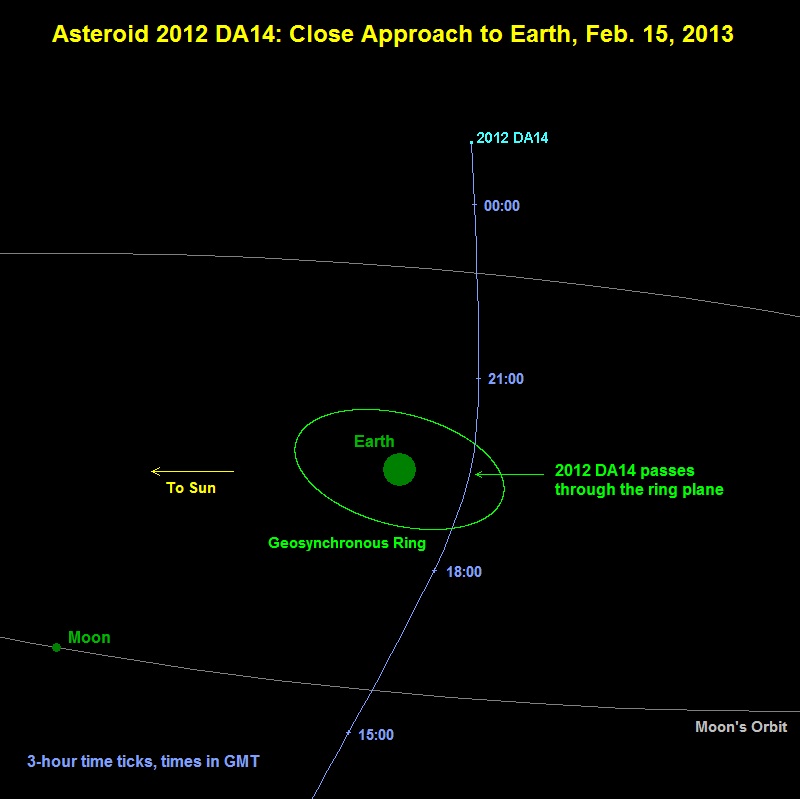Friday Flyby: How Scientists Track Near-Earth Asteroids

On Friday (Feb. 15), a space rock approximately the size of the White House will whiz past Earth, coming as close as 17,200 miles (27,700 kilometers) to the planet — a close call in astronomical terms. But how do scientists track an asteroid's path?
Telescopes and math. Observations of asteroids and other near-Earth objects are made optically; in the case of this week's flyby, researchers at Spain's La Sagra Observatory discovered the asteroid (called 2012 DA14), in February of last year. Once an astronomer identifies an object, its path can be tracked.
The flight paths of space objects are very predictable, said Mark Boslough, a physicist at Sandia National Laboratories in New Mexico who researches asteroid impacts.
"If you precisely know the location and the speed of something, well then, you can predict where it's going to be at any time in the future, as long as you don't go too far out," Boslough said.
2012 DA14 orbits the sun every 368 days, and has approached Earth relatively closely on approximately an annual basis, according to NASA. The discovery occurred during one of these approaches, but this year's asteroid flyby will be a significantly closer shave. The asteroid will pass within the zone around Earth in which satellites orbit, though it's not expected to threaten any of this equipment. [See Complete Coverage of the Asteroid's Flyby]
Once the asteroid is close enough, scientists can aim radar at the space rock to get a better look. That's the plan for 2012 DA14, NASA near-Earth object expert Don Yeomans said in an agency video interview. The equipment at the Arecibo Observatory in Puerto Rico and at the Goldstone Deep Space Communications Complex in California will make these measurements.
"The radars will be aimed at this object not at the very closest approach, because it's not on the right side of Earth, but they will be observing it a couple of hours later," Yeomans said in the video.
Get the world’s most fascinating discoveries delivered straight to your inbox.
"If we can get the radars on them, we can nail the orbit for the next several hundred years," he added, referring to near-Earth objects in general.
The radar measurements will also clarify the size of the asteroid. The current estimates peg the size at about 150 feet (45 meters) in diameter. For reference, that would make for a rock about the size of the White House.
But those size measurements are based on the brightness of the object as seen through optical telescopes, which can be deceiving. A darker-colored asteroid reflects less light than a lighter-colored one, so it's possible that 2012 DA14 is darker and larger than expected, or lighter and smaller.
"There's really a large uncertainty," Boslough said.
Fortunately, 2012 DA14 isn't threatening Earth, but that uncertainty would be something to reckon with if a near-Earth object did make impact, Boslough said. Scientists would be able to predict where the object would hit, but they wouldn't know exactly how much damage it would cause without knowing the size.
"Would we evacuate an area assuming that it's 150 feet in diameter, which is the best estimate, or would we err on the size of caution and say, 'What is the worst case?'" Boslough said, adding, "If we make a mistake, we want to make a mistake on the side of caution."
Follow Stephanie Pappas on Twitter @sipappas or LiveScience @livescience. We're also on Facebook & Google+.

Stephanie Pappas is a contributing writer for Live Science, covering topics ranging from geoscience to archaeology to the human brain and behavior. She was previously a senior writer for Live Science but is now a freelancer based in Denver, Colorado, and regularly contributes to Scientific American and The Monitor, the monthly magazine of the American Psychological Association. Stephanie received a bachelor's degree in psychology from the University of South Carolina and a graduate certificate in science communication from the University of California, Santa Cruz.



